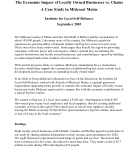As big box stores and chain retailers consume more and more undeveloped land, polluted runoff from their parking lots is placing an ever greater burden on the nation’s rivers, lakes, and coastal waters. Storm water control measures and filtration systems produce only modest improvement, according to experts. A better solution is to channel commerce back into compact downtowns and neighborhood business districts, which are far less polluting.
Runoff from streets, parking lots, and rooftops now ranks as the top source of water pollution, ahead of industrial discharges, according to the U.S. Environmental Protection Agency.
Retail development produces more runoff, and the runoff contains a larger concentration of pollutants, than any other type of land use. New retail centers generate 20 percent more runoff than industrial uses and more than three times as much as residential. Retail runoff contains phosphorous, nitrogen, hydrocarbons, metals such as zinc, road salt, pesticides, and herbicides.
Shopping centers are the worst polluters because of the volume of traffic they generate and the amount of land they devote to parking lots. “From an environmental standpoint, parking lots rank among the most harmful land uses in any watershed,” according to Tom Schueler of the Center for Watershed Protection. “Simply put, there is no other kind of surface in a watershed that produces more runoff and delivers it [to a local waterway] faster than a parking lot.”
A 250,000-square-foot Wal-Mart supercenter would typically have a 16-acre parking lot. For every inch of rain, a 16-acre parking lot produces 413,000 gallons of storm water. Over the course of a year, it will send 240 pounds of nitrogen, 32 pounds of phosphorus, and 5 pounds of zinc into the nearest waterway.
Runoff causes rivers to erode and flood, alters stream channels and habits, and raises water temperatures. Runoff pollutants lower dissolved oxygen levels and reduce the diversity and abundance of fish and aquatic insect species. According to large body of research, severe water quality degradation occurs when the amount of impervious surface in a watershed reaches as little as 10-15 percent of total land area.
Compounding the problem is the fact that corporate retailers are consuming more and more land to build the biggest stores and latest shopping formats. Retail space per capita has tripled over the last twenty years. Every new store means more roads and more parking lots. Meanwhile, thousands of older malls and big box stores are now vacant—while their parking lots continue to deliver runoff to nearby streams and rivers.
Finally, it’s worth noting that some of the major chains have a poor history of complying with runoff regulations. Legal action has been taken against Wal-Mart in several states for multiple violations of the Clean Water Act. The Connecticut Attorney General described the violations in his state as “irresponsible and reprehensible.” They resulted in pesticides, fertilizers, and other pollutants entering waterways and causing a “serious threat to water quality and public health.”
More stringent regulations and enforcement—such as requiring developers to install ponds and filtration systems—are important, but at best these systems produce only modest improvements. As Dana Beach of the South Carolina Coastal Conservation League notes, “Abundant research over the past three decades has proven that site-level practices, in the absence of land-use reforms, cannot protect aquatic ecosystems from decline.”
The only real solution is to limit the amount of impervious surface in a watershed. According to Tom Schueler of the Center for Watershed Protection, “The best way to minimize the creation of additional impervious area at the regional scale is to concentrate it in high density clusters or centers.” This means channeling retail activity back into downtowns and neighborhood shops.
These traditional, compact business districts produce far less polluted runoff than conventional shopping centers and big box stores. Multi-story buildings reduce the footprint of buildings. Higher densities and greater access for pedestrians and public transit mean significantly less land devoted to roads and parking lots.
Local and state governments can reinvigorate downtown commerce and protect waterways by revising their land use and economic development policies to prevent excessive retail development, limit auto-oriented big box retailers, support small-scale, pedestrian-oriented stores, and channel new investment into downtowns and neighborhood business districts.



